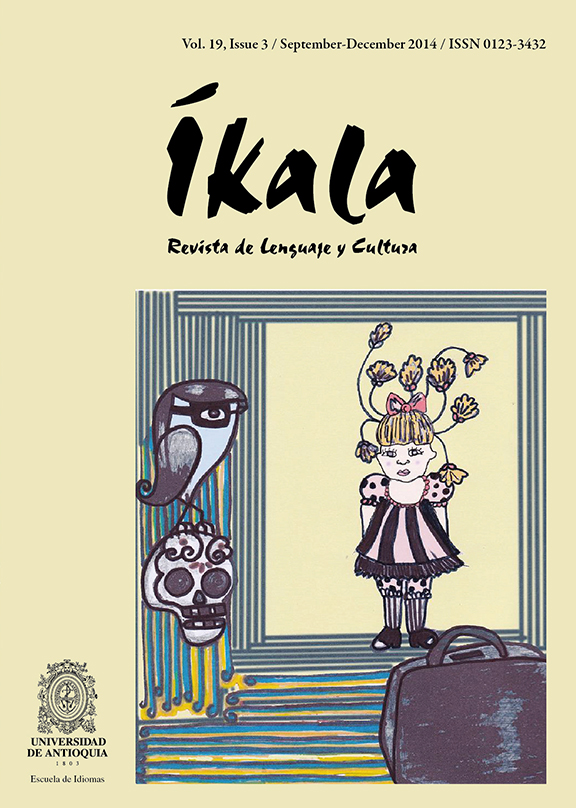Las Redes Sociales en el Aula: El Surgimiento de Roles para Profesores y Nuevos Enfoques para el Diseño de Cursos
DOI:
https://doi.org/10.17533/udea.ikala.v19n3a04Palabras clave:
Web 2.0, roles de los profesores, redes sociales, ambientes de aprendizaje mediados por TICResumen
Las herramientas web 2.0 en general y las redes sociales en particular son ampliamente usadas. Sin embargo, su uso en la enseñanza no se ha explorado a profundidad. Este artículo reporta los hallazgos de la implementación de una red social como apoyo virtual para un curso presencial. Los hallazgos muestran que la implementación de la herramienta tiene efectos en 5 áreas administrativas: (1) administración de la logística del curso, (2) administración de la información y el conocimiento, (3) administración de la comunicación, (4) administración del trabajo por fuera de clase y (5) administración de la facilidad de acceso. Las conclusiones de este estudio muestran que la implementación de la tecnología en el salón de clase implica nuevos roles para los profesores y la necesidad de usar nuevos enfoques para el diseño de cursos virtuales y de componentes virtuales.
Descargas
Citas
Brown, S. (2012). Seeing web 2.0 in context: A study of academic perceptions. Internet and higher education. 15. 50-57.
Bennett, S., Bishop, A., Dalgarno, B., Waycott, J. &
Kennedy, G., (2012). Implementing web 2.0 technologies in higher education: a collective case study. Computers and Education, 59, 524-534.
Creswell, J. (2007). Qualitative inquiry and research design: Choosing among five approaches (2nd ed.). Thousand Oaks, CA: Sage Publications.
Dwyer, C., Hiltz, S., & Passerini, K. (2007). Trust and privacy concern within social networking sites: A comparison of Facebook and Myspace. In Proceedings of the thirteenth americas conference on information systems. Keystone, Colorado.
Elmaziye, O. & Birikim, O. (2009). Web 2.0 in learning English: the student perspective. Procedia-Social and behavioral sciences, 1(1), 326-330.
Freeman, D. (1998). Doing teacher research: From inquiry to understanding. Boston, MA:Newbury House.
Florez, E., Pineda, J. & Garcia, N (2012). EFL students' perceptions about a web-based English reading comprehension course. PROFILE Issues in Teachers' Professional Development, 14(2), 113-129.
Gonzalez, A & Muñoz, J. (2011). Teaching reading comprehension in English in a distance web-based course: New roles for teachers. PROFILE Issues in Teachers' Professional Development, 12(2), 69-85.
Hemmi, A., Bayne, S., Land, R. (2009). The appropriation and repurposing of social technologies in higher education. Journal of Computer Assisted learning, 25(1), 19-30.
Jeffrey, D., & Hadley, G. (2002). Balancing intuition with insight: Reflective teaching through diary studies. The language teach, 26(5). Retrieved from http://www.jaltpublications.org/tlt/articles/2002/05/jeffrey
Kocak, U., & Guzin, S, (2009). Adoption of web 2.0 in distance education. Procedia. Social and Behavioral Sciences, 1, 818-823.
Lopera, S. & Osorno, J. (2012). Interaction in an EFL reading comprehension distance web-based course. Ikala. Revista de Lenguaje y Cultura, 17(1), 45-59.
Merriam, S. (1998). Qualitative research and case study applications in education. San Francisco, CA: Jossey-Bass.
Pai, P., Arnot, C. (2013). User adoption of social networking sites: eliciting uses and gratifications through and end-means approach. Computers in Human Behavior, 29, 1039-1053.
Pineda, J & Tobón, M. (2011). The use of blogs as learning platforms. ASOCOPI Newsletter, 3, 6-11.
Sanz, S (2005). Comunidades de practica virtuales: Acceso y uso de contenidos. Revista de Universidad y Sociedad de Conocimiento, 2(2), 26-35.
Salmon, G (2011). E-moderating. The key to teaching and learning online third edition. New York. Routledge.
Salmon, G. (2002). E-tivities. The key to active online learning. London. Routledge.
Salmon, G.(2013). E-tivities. The key to active online learning. Second edition. New York. Routledge.
Stake, R. (1995). The art of case study research. Thousand Oaks, CA:Sage.
Wenger, McDermott & Snyder (2002). Cultivating communities of practice: A guide to managing knowledge. Harvard Business School Press. Boston. USA.
Yin, R. (2003). Case study research: Design and methods. Thousand Oaks, CA: Sage Publications
Descargas
Publicado
Cómo citar
Número
Sección
Licencia
Derechos de autor 2014 Íkala

Esta obra está bajo una licencia internacional Creative Commons Atribución-NoComercial-CompartirIgual 4.0.












